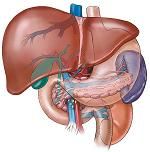Bulevirtide Shows Promise for Treating Hepatitis
Bulevirtide, a first-in-class entry inhibitor, showed promise for the treatment of hepatitis B and hepatitis D coinfection, a phase 2 trial found.

Bulevirtide in combination with tenofovir disoproxil fumarate (TDF) showed promising results for treating patients with coinfection of hepatitis B virus and hepatitis D virus in a recent phase 2 trial.
The study, published in The Lancet Infectious Diseases, included 120 patients in Germany and Russia with chronic hepatitis D virus infection (HDV) between Feb. 16, 2016, and Dec. 8, 2016, who received 2 mg, 5 mg or 10 mg of bulevirtide in combination with TDF or TDF alone. The study included 59 patients with cirrhosis.
“Blocking HBV and hepatitis D virus entry with bulevirtide is a safe and promising strategy to treat patients with chronic hepatitis D virus infection, even when cirrhosis has already been diagnosed,” the study authors, led by Heiner Wedemeyer, MD, of the Department of Gastroenterology, Hepatology and Endocrinology at Hannover Medical School in Germany, wrote.
HDV depends on hepatitis B virus (HBV) envelope proteins to complete its life cycle, and the coinfection causes more rapid disease progression compared with HBV infection alone, leading to cirrhosis within 5 to 10 years for 70% of patients and death within 10 years among 60% of patients.
Bulevirtide is a synthetic myristoylated peptide derived from the pre-S1 domain of the HBV large surface protein. It works by binding the sodium taurocholate contransporting polypeptide (NTCP) receptor, which is the entry pathway for the virus.
“In summary, we show that blocking the HBV–hepatitis D virus receptor NTCP leads to a significant reduction of hepatitis D virus RNA concentrations in the serum and the liver of patients with chronic hepatitis D virus infection, indicating effectiveness at all three doses administered,” the study authors concluded. “Bulevirtide was safe and well tolerated, including in patients with cirrhosis.”
At Week 24, 15 of 28 patients (54%) who received 2 mg bulevirtide achieved undetectable hepatitis D virus RNA, compared with 16 of 32 (50%) who received 5 mg bulevirtide, 23 of 30 (77%) who received 10 mg bulevirtide and 1 of 28 (4%) treated with TDF alone. Hepatitis D virus RNA concentrations rebounded 24 weeks after treatment cessation among 91% of study participants.
A subgroup of 22 patients underwent liver biopsy at baseline and completion of treatment, demonstrating a reduction in hepatitis delta antigen (HDAg)-positive and hepatitis D virus RNA-positive hepatocytes.
Patients treated with bulevirtide hadrapid improvement of alanine aminotransferase concentrations and liver stiffness.
Adverse events included asymptomatic salt increases and increases in alanine and aspartate aminotransferases, with only two serious adverse events attributed to bulevirtide.
An associated commentary by Takanori Ito and Mindie H Hguyen noted that therapeutic responses were not substantially different between different bulevirtide doses or cirrhosis status.
The duration of the treatment at only 24 weeks was a key limitation of the study, preventing long-term conclusions about safety, tolerability or efficacy. The study also may not be generalizable to patients with different HDV genotypes or ethnicities.
Treatment with peginterferon alfa (PegIFNα), which can be associated with intolerable side effects and high rates of relapse, is currently the only treatment for chronic hepatitis D virus infection recommended by the European Association for the Study of the Liver guideline.
Bulevirtide was formerly known as myrcludex B and has been conditionally authorized in Europe as Hepcludex.
